NYC Hotel Art Fairs – RedDot and ArtNow 2008
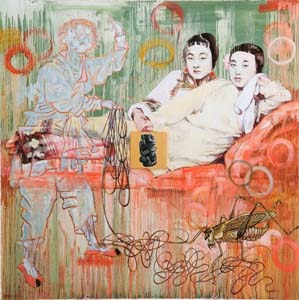 This year’s NYC hotel-based art fairs, RED DOT (where I had work shown through Brenda Taylor Gallery) and ART NOW, were an interesting mix of the easy and the challenging, the sophisticated and the repetitive. Chinese art was very well represented, sometimes overwhelmingly so. The prolific Hung Liu, represented by Nancy Hoffman and whose work I quite like, was seen frequently seen and unfortunately frequently imitated. Such seems to be the way with the Chinese market at the moment, and I heard more than one gallerist talking about “academy trained” and “soviet influenced”.In the way of repetition, there were far too many paintings consisting solely of big, bright splotches on glossy surfaces. Now, these may look good in a hotel lobby, but they come across as cheap commodity rather than serious art, particularly when they seem to pop up in every other room one visits. Paintings of this sort didn’t seem to show up in the fair marketing materials, so I can only assume the galleries grudgingly brought them along for the interior decorators who would inevitable scoop them up for corporate clients.
This year’s NYC hotel-based art fairs, RED DOT (where I had work shown through Brenda Taylor Gallery) and ART NOW, were an interesting mix of the easy and the challenging, the sophisticated and the repetitive. Chinese art was very well represented, sometimes overwhelmingly so. The prolific Hung Liu, represented by Nancy Hoffman and whose work I quite like, was seen frequently seen and unfortunately frequently imitated. Such seems to be the way with the Chinese market at the moment, and I heard more than one gallerist talking about “academy trained” and “soviet influenced”.In the way of repetition, there were far too many paintings consisting solely of big, bright splotches on glossy surfaces. Now, these may look good in a hotel lobby, but they come across as cheap commodity rather than serious art, particularly when they seem to pop up in every other room one visits. Paintings of this sort didn’t seem to show up in the fair marketing materials, so I can only assume the galleries grudgingly brought them along for the interior decorators who would inevitable scoop them up for corporate clients.
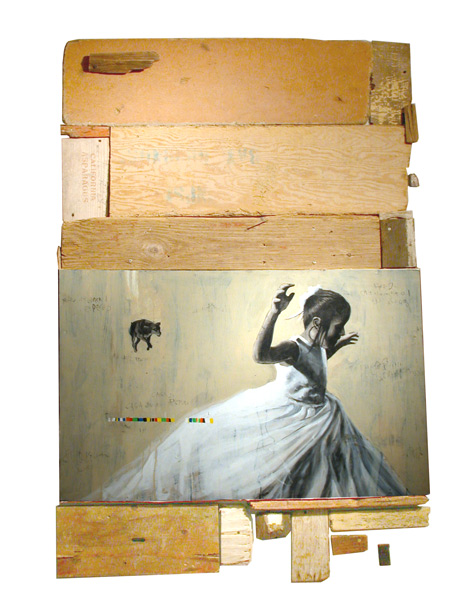 On the other end of the spectrum, there was some particularly strong work to be seen in a number of rooms. My favorite gallery in either venue was Jack Fischer Gallery who was showing some strong work including wonderful little paintings on sheetrock and other construction materials from Caleb Duarte and poetic drawings by John Hundt.
On the other end of the spectrum, there was some particularly strong work to be seen in a number of rooms. My favorite gallery in either venue was Jack Fischer Gallery who was showing some strong work including wonderful little paintings on sheetrock and other construction materials from Caleb Duarte and poetic drawings by John Hundt.
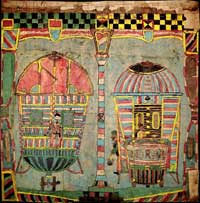 Another highlight of the fair was the work found in Stephen Romano’s unpretentiously presented space at the ArtNow fair. Steve carries outsider art but definitely has an eye toward the current scene. What caught my eye when walking in was a gorgeous Jeff Soto (not for sale) mounted in front of the television, not two feet away from an original Henry Darger. The Soto was the one from the front page of his website and there was something really compelling about seeing these two disparate works in such close proximity.
Another highlight of the fair was the work found in Stephen Romano’s unpretentiously presented space at the ArtNow fair. Steve carries outsider art but definitely has an eye toward the current scene. What caught my eye when walking in was a gorgeous Jeff Soto (not for sale) mounted in front of the television, not two feet away from an original Henry Darger. The Soto was the one from the front page of his website and there was something really compelling about seeing these two disparate works in such close proximity.
Steve also introduced me to the work of Charles Dellschau, an intense outsider artist from the late 1800’s who produced an incredible body of work (one of the the earliest coherent bodies of visionary art) and whose brilliant watercolors were truly fantastic.
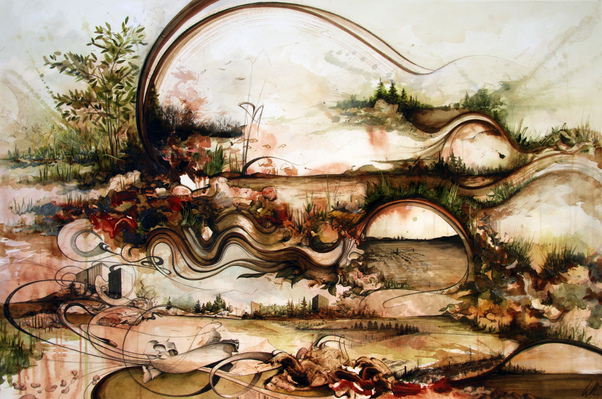 Finally, it was wonderful to see the lush, complex works of Josh Keyes and Gregory Euclide at the Limited Addiction space. Euclide’s work is hard to gain a full appreciation for online but in person it was thrillingly nuanced (incidentally, he will be shown at MASS MoCA soon). Likewise, the detail in some of Keyes’ paintings gets lost in reproduction and it was a pleasure to be able to spend time with the work in person
Finally, it was wonderful to see the lush, complex works of Josh Keyes and Gregory Euclide at the Limited Addiction space. Euclide’s work is hard to gain a full appreciation for online but in person it was thrillingly nuanced (incidentally, he will be shown at MASS MoCA soon). Likewise, the detail in some of Keyes’ paintings gets lost in reproduction and it was a pleasure to be able to spend time with the work in person
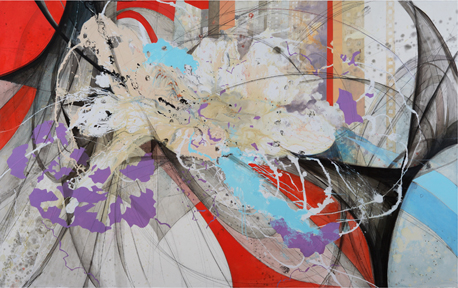
Emmy Cho at ABBA Fine art was also really great stuff.
Later that day, gallery hopping in Chelsea seemed like wandering in a ghost town compared to the fairs. The one exception to this solitude was the Marcel Dzama show ‘Even the Ghost of the Past‘ at David Zwirner. Upon entering the gallery, it was easy to see why it was mobbed. Outside of the fact the Dzama has become a celeb-du-jour, the work was extraordinary and represented a clear directional step for him. On display were a number of paintings which held some connection to previous works but also incorporated a number of elements that referenced historical figures or events. This left the work more open to connection with various levels of meaning. Also displayed were sketchbook pages, and in comparison to his previously exhibited sketchbook, these were much cleaner, more studied and less frantic in their mark making (I preferred the prior for their obsessiveness). Walking into the almost pitch-black room of the back gallery was an extraordinary visual experience, with Museum of Natural History sized dioramas of Dzama’s signature figures gracing the walls. These dimly lit scenes were oddly quiet despite their often disturbingly twisted subject matter.

Perhaps most indicative of his new-found affinity for art historical reference was a peep hole installation which closely mirrored Marcel Duchamp’s ‘Etant Donnes’, in which the viewer looks through a peep hole in a wooden door to see a nude woman lying spread-eagle on her back against a landscape. That the Marcel of this century is so boldly referencing the Marcel of last century is a dramatic turn in his work. Dzama’s peep hole seems a sort of continuation of the same story, with new clues and actors introduced.
While the Dzama show thrilled the mobs of gallery-goers with its showmanship and whimsy, the immaculately installed presentation was a nice contrast to the hotel rooms of the fairs which were a difficult venue in which to view art. While some gallerists imported impressive structures to mask the room, others left beds and fixtures in place (it costs extra to remove the beds). However, the sub-par experience of viewing art in a hotel bathroom was largely outweighed by the thrill of seeing such a broad array of work such a compressed time.
